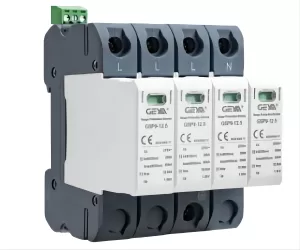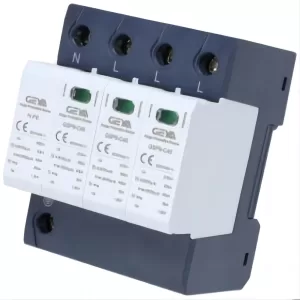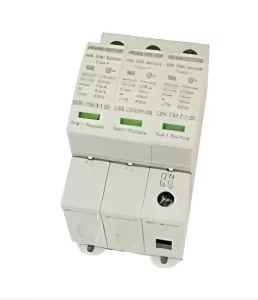
Understanding Transient Voltage Surge Suppressors
February 22 2024  1373
1373
Inquiry
Global electronic component supplier AMPHEO PTY LTD: Rich inventory for one-stop shopping. Inquire easily, and receive fast, customized solutions and quotes.
QUICK RFQ
ADD TO RFQ LIST
In this blog, we will delve into Transient Voltage Surge Suppressor (TVSS). Whether you have a home theater setup or simply a laptop you rely on, understanding TVSS can help you make informed decisions to protect your investments.
What is a Transient Voltage Surge Suppressor?

Types of TVSS
Type 1 TVSS:
- Installed at a building's service entrance, usually next to the main breaker panel.
- Provides the strongest defense against strong surges, including those brought on by lightning strikes.
- 200,000 amps of surge current is something it can manage.
- In certain places, commercial and industrial structures must comply with the code.

- Installed on a building's branch circuits, usually next to delicate equipment or at subpanels.
- Offers defense against power grid surges and other sources.
- Able to withstand up to 65,000 amps of surge current.
- Frequently combined with Type 1 TVSS to provide multilayer security.

- Installed right at the point of use, on individual gadgets or power strips, for example.
- Provides the least amount of protection, yet it's frequently the most practical and economical choice.
- Able to withstand up to 3,000 amp surge currents.
- Ideal for shielding individual gadgets against milder surges.
How Surge Suppressor Works?
- Normal Operation: The MOV regulates the flow of electricity via the surge protector and into your gadgets.
- Surge Detected: An abrupt voltage surge takes place. The MOV perceives it as a threat and responds immediately.
- Diverting the Surge: By activating the bypass path, the MOV stops the excess voltage from reaching your devices by enabling it to go safely to the ground wire.
- Back to Normal: The MOV returns to its typical state and regular electricity flow occurs once the surge passes.
How to Test a Surge Suppressor?
Although it makes sense to want to check the performance of your surge suppressor, it's crucial to realize that doing so at home is not safe or accurate. This is the reason why: Complex Mechanism: Metal Oxide Varistors (MOVs), an intricate component that deteriorates with each shock it absorbs, are the foundation of surge protectors. To test them, a surge is simulated, which may worsen the MOV and jeopardize subsequent protection. Specialized Equipment: Surge generators and oscilloscopes, for example, are examples of specialized equipment that is needed for accurate testing but are not easily accessible for home usage. DIY test attempts with the wrong equipment might be risky and yield inaccurate findings. Manufacturer Recommendations: Because home testing can be inaccurate and pose dangers, most manufacturers advise against it. They advise replacing the surge suppressor after a predetermined amount of time, usually two to three years, according to the lifespan recommendations. Alternatives for Evaluating Functionality:- Visual Inspection: Check for any signs of physical damage, such as loose parts, melted plastic, or burn marks. These point to possible problems.
- Status Indicators: Some surge protectors come equipped with LEDs or lights that blink to show when they're working. To find out their exact meaning, go to the user handbook.
- Ground Fault Circuit Interrupter (GFCI): If your surge suppressor has a GFCI outlet, insert a tested GFCI tester to see if it functions.
Where to Place a Surge Suppressor?
Whole-House Surge Protectors:- Installed at your building's main service door by a licensed electrician.
- Safeguards every device and circuit in your house.
- Placed on branch circuits near delicate electronics, like computers, home entertainment systems, or medical equipment.
- Can be put in junction boxes or subpanels.
- Immediately plugged into the sockets that your gadgets are connected to.
- Perfect for safeguarding individual devices like gaming consoles, TVs, PCs, and home entertainment systems.
Can Surge, Suppressors, Go Bad?
Yes, surge suppressors can go bad and lose their ability to protect your electronics. Here's why and how to know if yours needs replacing: Degradation Over Time:- Metal Oxide Varistors (MOVs), for example, are a component used by surge protectors to absorb and redirect surges. Their efficacy gradually decreases with each surge they absorb due to a small degradation in the MOV.
- Even slight spikes can cause this cumulative damage.
- Physical damage: Check for loose parts, melted plastic, and burn marks. These suggest that the suppressor may be compromised due to overloading.
- Status indicators: Some surge protectors include lights or LEDs integrated right into the device to show when it's operating. Check the handbook to find out what they signify. These signs, nevertheless, might not always be trustworthy.
- Age: Surge protectors only last two to three years on average. It is advised to replace it after this time for best protection, even if it seems undamaged.
Conclusion
In conclusion, Transient Voltage Surge Suppressors (TVSS) are the unseen power surge protectors for your electrical equipment. Keep in mind that even small surges can silently harm delicate parts, necessitating expensive replacements or repairs. Investing in high-grade TVSS protection will preserve your expensive devices and guarantee that they will continue to work.Populer Posts
XCV600-4BG432C
AMD
M1A3P600-FGG484I
Microchip Technology
A3PN125-1VQ100
Microchip Technology
1SG110HN1F43I1VG
Intel
LFSC3GA115E-5FFN1152I
Lattice Semiconductor Corporation
EP2C50F672C6
Intel
5AGXFB1H4F35C4G
Intel
5SGXMABN3F45C2G
Intel
5SGXMA4K3F35I3G
Intel
M2GL025T-FG484I
Microchip Technology
5SGXEB6R3F43I4N
Intel
A40MX02-PL68I
Microchip Technology
